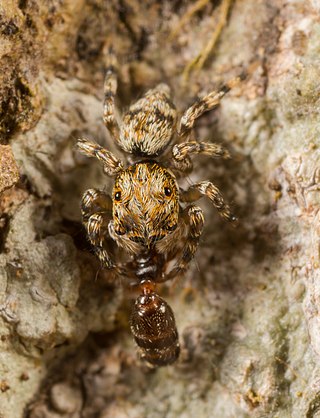
Ground spiders comprise Gnaphosidae, the seventh largest spider family with over 2,000 described species in over 100 genera distributed worldwide. There are 105 species known to central Europe, and common genera include Gnaphosa, Drassodes, Micaria, Cesonia, Zelotes and many others. They are closely related to Clubionidae. At present, no ground spiders are known to be seriously venomous to humans.

Evarcha is a genus of spiders in the family Salticidae with 85 species distributed across the world.

Habrocestum is a genus of jumping spiders first described in 1876. They mostly occur in Eurasia and Africa, though one species has been found in Australia and another on the Solomon Islands.

Pseudicius is a genus of the jumping spiders first described by Eugène Simon in 1885. The name is combined of Greek pseudo "false" and the salticid genus name Icius. The small genus Wesolowskana should possibly be included in this genus. There is some dispute whether Afraflacilla is a distinct genus or should be included in Pseudicius. Festucula and Marchena are other close relatives, these genera form a monophyletic group.

Rhene is a spider genus of the family Salticidae.

Prodidomidae is a family of spider, sometimes called long-spinneret ground spiders. It was formerly regarded as a subfamily of Gnaphosidae, but was raised to a family in 2022.
Camillina is a genus of ground spiders that was first described by Lucien Berland in 1919. They are very similar to sister genus Zelotes.
Penestomus is a genus of African araneomorph spiders in the family Penestomidae, and was first described by Eugène Louis Simon in 1902. The genus was formerly included in the family Eresidae, but was elevated to its own family in 2010. It is now considered closer to Zodariidae.

Trachelidae is a family of araneomorph spiders first described by Eugène Simon in 1897 as a subfamily called "Tracheleae". The Trachelidae family, also known as "ground sac spiders", is within the group of spiders known as the RTA clade, which includes mostly wandering spiders that do not use webs. Spiders in the Trachelidae family are characterized as being 3-10mm long and having a red cephalothorax and a yellow/tan abdomen. They are commonly found indoors. It was placed in the family Clubionidae, then later in Corinnidae when the Clubionidae were split up. The first study that suggested Trachelidae should be considered its own family was done by Deeleman-reinhold in 2001 as part of an analysis of RTA Clade spiders. An analysis by Martín J. Ramírez in 2014 suggested that it was not closely related to other members of the Corinnidae, and was better treated as a separate family. It was then placed in the CTC clade of spiders, or the Claw Tuft Clasper clade, which is a group of spiders that have two tarsal claws with tufts of hair.
Drassodella is a genus of African araneomorph spiders in the family Gallieniellidae, and was first described by John Hewitt in 1916. Originally placed with the ground spiders, it was moved to the Gallieniellidae in 1990.

Wanda Wesołowska is a Polish zoologist known for her work with jumping spiders. She has described more species of jumping spider than any contemporary writer, and is second only to Eugène Simon in the history of arachnology. Originally a student of ornithology, she developed an interest in jumping spiders while still a student at the Siedlce University of Natural Sciences and Humanities in the 1970s.
Leptodrassus is a genus of ground spiders that was first described by Eugène Simon in 1878.
Leptopilos is a genus of ground spiders that was first described by G. Levy in 2009.
Prodidomus is a genus of long-spinneret ground spiders that was first described by Nicholas Marcellus Hentz in 1847.
Zimirina is a genus of long-spinneret ground spiders that was first described by R. de Dalmas in 1919. It was transferred to the ground spiders in 2018, but was returned to Prodidominae in 2022.
Rhene amanzi is a species of jumping spider in the genus Rhene. The male was first identified in 2013 and the female in 2018. The species is named after the Amanzi Private Game Reserve in Free State, South Africa, which is the only place that it has been found. It is dark brown, almost black, and small, although the female is larger than the male. The upper part of the cephalothorax, or carapace, is trapezoid and dominated by a large trapezoid eye field. Its front legs are fatter than the others. Its copulatory organs are distinctive. It differs from other spiders in the genus by the large triangular embolus found on the male and the shallow notch in the female's epigyne. The male also has a very small palpal tibia that has a sharp curved spike, or tibial apophysis, which ends in a point.
Rhene timidus is a species of jumping spider in the genus Rhene that lives in South Africa. Only the female has been described, in 2013. The spider is typical of the genus, but larger than Rhene facilis, with a relatively large abdomen measuring 3.5 mm (0.14 in) in length. It has a distinctive epigyne featuring spiralling ridges.
Capobula is a genus of southern African spiders in the family Trachelidae. The type species was first described by Eugène Simon from a juvenile found in South Africa. It was placed with Orthobula for several morphological similarities, including a large sclerite beneath the abdomen and spines behind several of the legs. After a more thorough examination in 2021, including both male and female adults, enough distinctive features were found in the holotype and several other newly discovered species to warrant a new genus.







